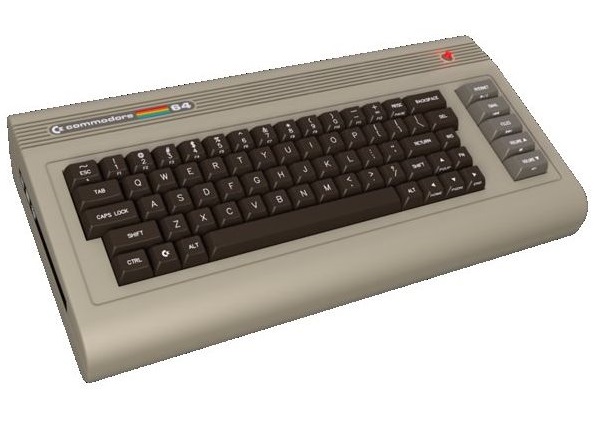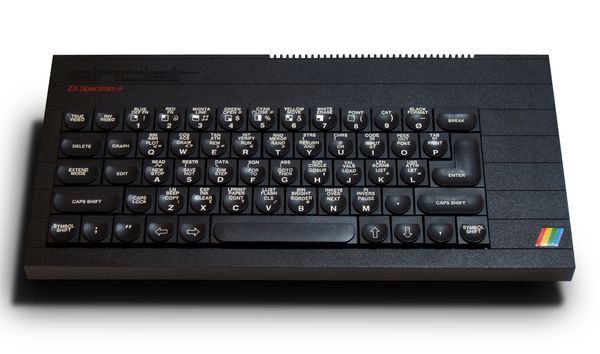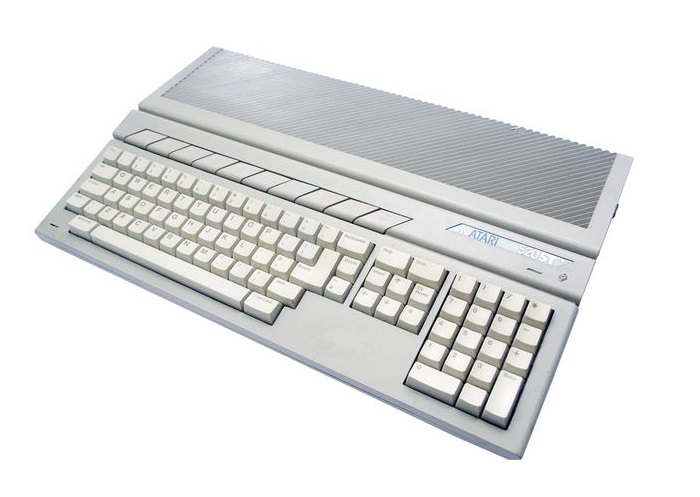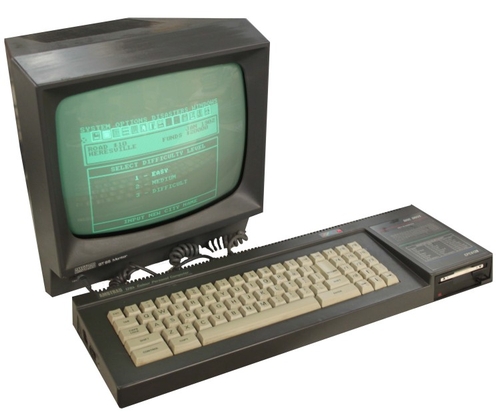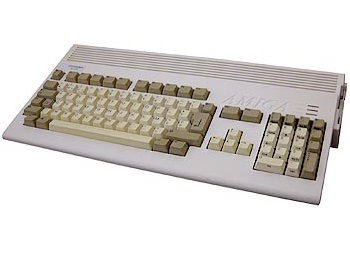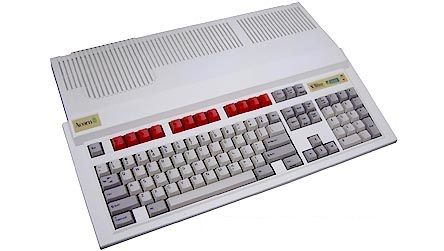
Micro Mart
 19th April 2007
19th April 2007
Categories: Summary: My Favourite Machines
Published in Micro Mart #949
My Favourite Computer
Everyone's got a favourite; maybe it's your first, maybe it's your last, maybe it'll your next - whatever, we've all been bitten by the bug at some time and fell in love with the sights, sounds and sometimes smells of computing. So, which machines of yore - or not, as the case may be - would the Micro Mart team pick at a push?
Jason D'Allison: Commodore 64
My favourite computer ever is the Commodore 64. My parents bought me one in the spring of 1983, just after the system's UK launch. Excluding games consoles, it was the first computer I owned. It cost a colossal £399, over three times the price of the competing Sinclair Spectrum (the 16KB model), and in hindsight, I was pretty lucky.
Only one other classmate had a C64. His house was closer to school than mine, so at dinnertimes several of us would bomb back there, wolf down our sandwiches, then cram in 35 minutes on games like Revenge Of The Mutant Camels, Everyone's A Wally and Thing On A Spring. Heaven alone knows how many joysticks we broke playing Daley Thompson's Decathlon. And I'd rather forget the ear-bashings we used to get from being routinely late for afternoon registration!
One of my reasons for loving the C64, of course, is that it's a vehicle for a nostalgia trip. It lets me remember the anticipation my mate and I would feel whenever we'd walk to Gordon Foster's, our local computer shop, to buy the latest title by Llamasoft. It lets me remember how, being regularly short of funds, we'd need to borrow one lad's pocket money (he never seemed to spend it!}, which we'd pay back in instalments. And it lets me remember the thrill and pride we'd feel when, having been the first in the UK to complete certain games, we'd receive prizes from software houses or see our names printed in Zzap! 64.
Another reason for my affection is that the C64 was the best home computer of its time. How our ears rejoiced at the magical music Rob Hubbard coaxed from the SID sound chip! How our eyes goggled at the bizarre visuals Jeff Minter lured from the VIC-II graphics chip! Every Spectrum owner lusted after a C64, though none of them ever admitted it, and anybody with an Oric-1 or Dragon 32 knew the best course of action was to keep quiet. The C64 was the daddy.
Of course, it wasn't all about games. Using the machine's in-built version of Microsoft BASIC, I learned to program. I never pursued programming as a career (though I still dabble in Visual Basic), but one member of our gaming group advanced to C++ and now programs for a living. For me, the C64 made me want to find out how computers ticked - it was instrumental in my journey to becoming an 'expert' in PCs.
And now all this talk has given me the urge to get my old machine out of the loft. Yes, I've still got it, including the box (complete with the price sticker). Sometimes an emulator just doesn't cut the mustard - I want to see the real flashing cursor and the immortal 'PRESS PLAY ON TAPE'. And after all, 2007 sees the platform's 25th anniversary (in August). So raise your glasses, friends and neighbours, to the Commodore 64!
Jenny Sanders: Acorn Risc PC 600
Throw yourself back about twelve years, when Acorn still existed and owning a Pentium PC was only for those who didn't need to eat. The idea of a home computer being an essential purchase was still taking off, even after the madness that was the 80s - and having two was, frankly, a bit poncey.
Well, we went down the poncey route, but with a cunning plan to stop the neighbours talking - both of ours were in the same case. Yes, it was a good old Risc PC 600 which actually had a PC card in it [not many of them did), and boy, was it useful. Constructed in natty-looking 'slices', each of which could hold extra drives and expansion cards*, it allowed my technology-obsessed brain access to not only the 30MHz ARM 610 processor, but a 100MHz 486DX - and often at the same time.
Every day I would turn on a computer which was lighting-fast and almost unimaginably stable, and allowed me to get all my work done without being harassed by smug paperclips, overactive hard disks or blue screens of death. And then, when I wanted to play a game, I'd boot the PC card and be able to amuse myself with all the big titles of the era - Quake, Monkey Island, Actua Soccer, The 7th Guest - er, maybe not that last one - and the quite wonderful NHL '95.
If I needed to look at a file from a PC, the Acorn would read it; and if I needed to view something off a Mac, the PC would read it, making me possibly the most compatible student to grace the campus. Even better, the speed of the PC card was enough to keep up with the rapidly-progressing market for quite some time - our P133, even without independent graphics or sound, did a decent job with most applications, including Photoshop and Cakewalk.
Yes, it wasn't without its problems, and I learnt more about interrupts, IRQ, memory allocation and 'minimum system requirements' than most females of my generation ever will. But what a fantastic cross between practicality, entertainment and education - and what a testament to cross-platform co-operation. It was almost a pity that there was no slice of Apple (do you see what I did there?).
*I am absolutely not joking when I say that someone once built a grill into theirs.
Simon Brew: ZX Spectrum+
So here's my potted computing CV: Apricot, Link 380Z, Atari, Dragon 32 (what a machine that was!), Amstrad PCW9512, umpteen PCs, a couple of Spectrums, the terrific Amiga 500 and a fair few games consoles.
The most important of them all? Ironically, it's the cheapest computer I ever had: the ZX Spectrum+.
Of course, its low price was but one part of the appeal, allowing me and countless others a genuinely affordable way into a fascinating hobby. But that's not the reason it's here. Mind you, it's hard to pinpoint one specific explanation, and perhaps within that lies the answer. For the ZX Spectrum+ didn't just hook me completely into computing, it opened the door into several different areas of it.
On one hand, naturally, there were the games. I can't lie: I'd reckon at least 70% of my pocket money was spent on accruing the shelves of games I eventually ended up with (and, twenty years later, fevérishly stuffing into an emulator).Just listing some of them now makes me dewey-eyed: Match Day 2, Head Over Heels, Jack The Nipper, Contact Sam Cruise, Dynamite Dan, Chuckie Egg, Daley Thompson's Keyboard-Breaking Decathlon - it's an endless list. Just as, if not more, interesting was the thriving independent gaming scene. It seemed anyone could write and publish a game, and many of them did. I lost (and I wasn't even in my teens at the time) many days managing a virtual brewery, for instance. It scares me, too.
But soon it went beyond that. I taught myself to program using the crude-yet-effective Spectrum BASIC, I dabbled in computer graphics for the first time, I attempted to tease all sorts of symphonic delights out of the BEEP command, and more than once lost a fair few hours' work courtesy of attempting to save data to tape.
Yet that was the beauty of the Spectrum. It was never plain sailing, yet for so many of us, it significantly lowered the barriers of entry to computing in several senses, and pretty much challenged you to make the most of what was, in retrospect, fairly limited hardware. But back then, we didn't care about gigahertz wars: we just wondered whether the long program listing we'd typed in was going to work.
It didn't matter that its peers had better graphics, or had better sound output, or an army of followers determined to slam Clive Sinclair's baby through the letters pages of any multi-format magazine that would listen. Because the Spectrum leaves a legacy that's perhaps more pertinent and important than any other machine before or since: it single-handedly not only got a generation interested in computing as a hobby, it also showed them that there was far more to a computer beyond the joystick.
And its keys fell out, too. Bargain.
Mark Pickavance: BBC Model B/Atari Mega ST
Gosh, what a question! I've had so many, some I've surely forgotten about. Two machines, however, stand out from the rest as the ones for which I have the fondest memories.
The first was by Acorn, the BBC Model B, for which I wrote my first commercial software. It was an amazingly reliable and solid piece of equipment, and I learned to love the clacky keyboard and its ROM firmware-based applications. Over time I added many things to mine, including the 6502 second processor, using the 'Tube' connection. And I even managed to get hold of a special version of Elite which ran using both processors in mode 4 graphics, and with more 'details'. What I can't recall is where it ultimately went, but I think it was donated to a school in the late 1980s.
The other hardware which I became very attached to was my Atari Mega ST (MEGA4), for which I had all the possible optional extras. They included the matching hard drive, the 'high res' 640 x 400 dedicated mono monitor and the Atari laser printer. It was a great workhorse, and great fun for games into the bargain. It was actually the third ST I'd owned, after I'd killed one and the other I'd sold to buy the Mega ST. I spent many hours on this desktop publishing, games designing, or playing the odd game of Xenon or Dungeon Master.
It's was the first system I owned where the keyboard and computer weren't in the same box, and it was also the first that I used to ray trace graphics.
While I'm sure some of my recollections are rose-tinted versions of those times, the idea of a machine that booted its OS almost instantly from ROM now sounds like a very desirable thing. It also did some other amazing tricks, like driving a MIDI keyboard, and emulating an Apple Mac. For that purpose I had the real ROMs from a real Apple in a cartridge which plugged into the ST, and then booted an emulation program. As I remember, most Mac applications running on it thought they were running on an Apple Lisa, because of the extra screen resolution. They also ran faster than the Mac because the ST ran its memory at the same speed as the processor, and not half speed as on a real Mac.
While not everything ran, many things did, and it gave me an entirely new perspective without the considerable cost of buying an Apple machine.
I do also recall being very disappointed with the follow-up ST machines, and after a brief dalliance with both the Amiga and Archimedes, I ended up with my first PC.
Jason Walsh: Amstrad CPC 6128
I'm not sure what my favourite computer is - probably my first ever Mac or my old Atari ST - and these days I simply use computers as mere tools, and the idea of having a favourite seems peculiar to me. On the other hand, I do know what the most important computer I ever owned was: an Amstrad CPC 6128.
The CPC was not in any way a spectacular computer. In fact, in many way it was quite poor. In later years, I found out that its disk drive, a bizarre 3" drive that virtually no other computer ever used, was driven by an elastic band and the machine's expansion ports were edge connectors, banned in Germany because of their propensity to fire out electromagnetic radiation. That it was released in the same year as the Apple Macintosh boggles the mind. On top of this, I didn't get as much from the CPC as I could have. For a start, any of my friends who owned CPCs had 464s, not 6128s, so if I borrowed a game it was on tape, not disk. When I bought games myself I invariably bought them on tape, not only so that I could swap and loan them, but also because my family simply couldn't afford the more expensive disk editions.
The greater RAM of the 6128, a whole 128k, was rarely used except when some later games used it to obviate the need for the hated multi-load. This was a double-edged sword, though. For sure, multi-load was deeply irritating, but it seemed the longer the load time of a tape game, the more likely a read error was.
Digital Research's CP/M was bundled with the computer and I loaded it plenty of times. I never fully understood what it was for or, indeed, how to use it. Ironically, I would later use it without realising - the Atari ST's operating system, TOS, was actually a version of CP/M for Motorola 68000 CPUs with GEM, a Mac-a-like user interface slapped on top.
So why, then, do I still harbour fond memories of the Amstrad CPC? Simple. I wouldn't be the person I am today without it. I had owned a computer before, a Commodore Vic-20, but I was too young to use it for much and as I grew older its limitations seemed ever more obvious.
With the CPC, though, I became totally accustomed to computers. I learned to program in BASIC - badly. I grew accustomed to what a computer was and how it worked. I learned to type - sort of. In short, I was very well placed for the later domination of our lives by information technology. Looking back, I can now see that it changed everything for me. During the 1980s parents fantasised about their children becoming 'whizz kids', pulling down salaries that would make an investment banker blush working with these strange machines. I never did become Eugene Evans, but there's a good chance I wouldn't be doing the work I now do were it not for this humble, flawed system. I almost feel like forgiving Amstrad boss, Alan Sugar, for his BBC television show The Apprentice.
And, of course, I played Elite - something I have done on every computer I've owned since, including versions for both Linux and Mac OS X on the MacBook Pro that I'm typing this on right now.
Martin Anderson: My Current/Future PC
I love 'retro', and I'm old enough for most 'retro' to also qualify as 'nostalgia'. Therefore I thought very hard about the contenders for My Favourite Computer. Could it be the Apple Classic, the truly iconic all-in-one Macintosh that prefigured the iMac and was my introduction to desktop publishing and word processing? What charm it held for me back then, with its 9" built-in greyscale monitor, 16MHz bus speed, whopping 1MB of memory and ability to open Word 5.1 in only two minutes. And how those specifications paled next to its successor, the turbo-charged Power Macintosh 9600 with its dizzying array of PCI expansion slots, science-fictioney 50MHz speed, default 4GB 7200rpm hard drive and ability to show you a model of Big Ben in 3D via OpenGL.
Further back yet, perhaps even my old Sinclair ZX Spectrum, with its Druidic programming commands and excitingly unstable tape-based loading routines could rise from its very humble specifications to command my highest affections as I look back over years of keyboard-bashing...?
Nah. My favourite computer is the one that does 10000 x 6000 pixel 300dpi 3D rendering with 4x anti-aliasing and full radiosity as a real-time preview in Cinema4D at 60fps; the one that handles high-definition video from After Effects with no penalties for filters or other special effects applied, and renders it to disk as fast as the hard disk itself can save it; the one that boots Windows from a cold start to a state of usability in the space of a key-stroke; the one with RAID-10000000 utilising an array of biological, yoghurt-based hard disks so fast that they've saved and backed up my entire day's work while I'm still walking yawnfully toward the PC with my morning coffee; the one that can switch instantly between Linux and Windows by saving the user states to DDR? RAM and performing reboots as fast as switching focus between windows.
And every computer I have ever had, including my current one (which is not terribly humble by most standards) has been my favourite computer, because it is nearer the above-specified, rather fantastical computer than the previous one was. I certainly have little to complain about with my current set-up; the Core 2 Duo 6700 is a very fast processor with 4MB of L2 cache, and tears through 3D renders and video despite the bottleneck of a budget motherboard and RAM. For Word processing and web-browsing it is total overkill. But it doesn't have a thought-control interface...
Joe Lavery: BBC Model B
The BBC Micro Model B First released in 1981. It was my first real computer and the machine I learned to program with; I also used it to create my first digital drawings and eventually used it to write my first articles with.
When it was introduced, the 'Beeb', as it was affectionately known, was quite a show stopper. The model A came with 16k of RAM (a megabyte was not even heard of then). In fact, I waited patiently in the computer shop on the day it arrived, while the engineers upgraded my new purchase to the model B specification. This added another 16k to the memory, making a massive total of 32k.
Nevertheless, the Beeb was fast for its day and seemed somehow more accessible than today's machines - what I would call a true enthusiast's computer. It was initially supplied with a tape drive for loading and saving programs, but had BBC Basic in ROM. The upshot being you could switch on and start programming in a matter of seconds. It wasn't long before other companies started producing similar software on EPROM, which you could plug into the spare ROM sockets on the motherboard. One product I bought was Wordwise, a word processor from Computer Concepts and like other similar ROMs, it could be launched instantly by typing *W. (I'm surprised I still remember that after all these years).
The graphics were pretty abysmal by today's standards but considered cutting edge at the time, with a selection of graphic modes and resolutions you could select. I recall mode 7 was a teletext mode which had sixteen colours but very low resolution, and mode 0 was only two colours but offered the highest resolution.
Because it came with quite a powerful BASIC, it seemed natural that owners would learn to program and in my case it was more the lack of any software that became the real spur to learn. I recall buying magazines full of BASIC listings you had to type in, and if you've ever done any programming you'll know that a comma in the wrong place is enough to stop the program running. So debugging these quite simple utilities was very educational; it became a battle of wills between man and machine to get them running. Not an easy task, particularly when sometimes the listings themselves were wrong.
The Beeb also introduced me to computer games, too. Remember Elite? Well the Beeb had it first and I played it for more hours than I care to admit. Anyway, I still have my old Beeb tucked away in some dark corner and regard it with fond memories.
Sven Harvey: Commodore Amiga 1200
I have used and owned a myriad of computers. I got rid of my A500 for an A1500, and then jacked in that base unit (keeping the periphery) to get my mitts on one of the new AGA machines, after initially not being impressed until I saw some of the early AGA games and demos running.
I was trying to save up as fast as I could to get one, as frankly the £10 to Comic Relief in my view was actually a draw towards the Comic Relief bundle. Then in April, Comet advertised that the bundle had dropped £100 to £299.99. I was lucky as it only had a couple left at the Selly Oak store in Birmingham.
The A1200 is the smallest Amiga with a full numeric keypad, but under the bonnet it is far more interesting. The AGA or AA chipset offers an improved graphical capability over the older machines, as well as the 14MHz 68020 compared with the 7MHz 68000 in the A500 and A1500, but what was key for the future development of the unit were the little extras - the built inthard disk controller, the clockport which initially no-one had an idea about, the CPU/DMA trapdoor slot, the mysterious blanking plate at the back of the machine and the PCMCIA slot. Little did anyone know in 1992 that these little extras would allow a 4GB hard disk, a soundcard, a PowerPC processor with 256MB of RAM and a graphics card to all be installed internally (well, sort of!) and a SCSI interface and CD-ROM drive connected to the PCMCIA slot (or these days even a wireless network card.)
One key difference, however, from the A500 especially, and the A1500 in my case, was the fact that the machine was powerful enough and had the much better OS to allow more serious use above and beyond gaming and Deluxe Paint. It wasn't long before Digita (Wordworth/Digita Office) and Softwood (Final Writer/Final Office) proved the point, and software such as Photogenics underlined the fact.
In my opinion, it simply offers the most potential of all of the Amiga range, it can be upgraded way more than it should ever have been able, and arguably more than even the big box models. It embodies everything that Amiga computing (and therefore true home computing) is about, offering a machine that out of the box happily does leisure and basic work, and with a fairly modest upgrade can be used for a plethora of applications, but can also be taken to scary heights of capability for a fifteen-year-old machine!
Sebastian Robinson: Acorn Risc PC
My favourite computer ever was also one of my first. An Acorn Risc PC with a whopping 30MHz ARM 6 processor and 64MB RAM. It later gained the 2MB video memory upgrade (allowing it to display 32-bit colour!) and a 203MHz StrongARM processor.
The Risc PC really was ahead of its time, especially in the early years. Released in 1994, the RISC OS operating system was already way ahead of Windows 3.1 in almost every respect. When Windows 95 came out, rumour had it that Bill had checked out RISC OS and liked it so much, Microsoft pinched some of the best bits. At the bottom of the RISC OS screen was the 'icon bar' with a clock on the right hand side and icons for currently running programs to the left. You could drag and drop data between applications and to save a file, you dragged its icon to where you wanted it stored. RISC OS also had a desktop that worked in a very similar way to today's Windows desktop; you could set a background picture or link to your favourite programs from there. This was all available for Acorn users from 1989 in the Archimedes series, six years ahead of Windows 95 which went some way towards matching RISC OS for ease of use.
Some of the best bits of the Risc PC's hardware are also now commonplace. For example, the ARM processors later developed into Intel's XScale range as found in many PocketPC PDAs. What's more, the processor in the Nokia smartphones such as the N-Gage and N80 is an ultra low power cousin to the ARM 6 in my Risc PC all those years ago. The Risc PC had all of its operating system stored in solid state ROM chips to make it ultra stable and quick to boot up. Vista has a function called 'ReadyDrive' where a fast suspend is possible by storing the operating system in a solid state area of the hard drive. It took the PC architecture some thirteen years to catch up in this respect and still it doesn't benefit from the OS stability that operating system storage in read-only ROM chips does e
It's humbling to think that my phone now has more memory and a slightly faster processor than my top of the range 1994 Risc PC, but it shows that the underlying technology was good. Acorn no longer exists but its Risc PC is a prime example of British technology being poorly marketed and perhaps too far ahead of its time.
Kevin Pocock: The Self-Built PC
Well I've got a brand new rig since our last revelations, and that's the one I'm giving the vote to. Sure, I've owned a C64, Amiga 1200, some Daewoo thing and an Amstrad (which clearly made an impact}, but none cut the mustard. Nothing can compare to the sheer sense of satisfaction that comes with owning a computer that I can throw pretty much anything I need to at, and know that it can handle it because that's how I designed it. I built it on my own, to my own specifications and in my own time, and in my mind these are the systems that come out on top.
Unlike many of my previous computers that have been built for me either partially or fully, allowing me a restricted amount of legroom to tinker, modify and - in some cases - destroy, my current system was born from nothing but a large selection of e-tailer components and the desire to build what I wanted from scratch, to a budget I was prepared to make allowances with. Tower, motherboard, PSU, graphics card, RAM, hard and optical drives, even a new monitor all hand-picked by yours truly after reconnaissance, consideration and judgements. It was built from the carpet of my bedroom upwards, and to me, that's what computing is all about. The reward you get from making your own choices and spending time and energy to end up with something that works how you want to is incredibly satisfying.
I know that my new computer will handle current 'high-end' games pretty well because I built it that way. I know that it can store music, pictures and movies on it because I built it that way. And, I know it's running Windows XP and hasn't come with Vista pre-installed (ahem) because, yes, I built it that way. Of course, I take the point that even in a couple of months, my 'Favourite Computer Ever' won't be as shiny and capable as it currently is, but you never expect hardware to last long.
I'm afraid I don't subscribe to the rose tinted days of old when I needed a cassette deck to load a copy of a Batman game I shared with my brother. I try not to live in the past and so neither does my choice for this feature. I earned the resources to buy it, paid the price, made my choice and am happy with the results. What's in it? A Coolermaster Centurion 5, Hiper 530W PSU, MSI K9A Platinum, AMD Athlon 64 X2 3800+, 1GB DDR2 566MHz RAM, Maxtor Diamondmax 230GB, LG Lightscribe DVD+RW and a Radeon X1900GT. I like it a lot, and it just... works.
Anthony Enticknap: Commodore 64
King of Indecisive that I am, I find it hard to pick a favourite anything. Computer-wise, there was the Amiga 500, which opened up the world of Deluxe Paint and Speedball 2; the various consoles which I inherited from my elder brother; and the Atari STe, which introduced to me the world of icon-driven operating systems. As much as I loved these machines, though, I decided not to opt for any of them, or even my first PC. And obviously ruling out the Sinclair ZX Spectrum +2A that never worked, that pretty much leaves me with one machine: the Commodore 64.
My reasons for choosing this particular piece of kit are partly sentimental. It was the first computer I remember my father buying, and I recall waiting at the bus stop with him as he held the box under his arm. At the time, I had no idea what it was. That was soon to change though, as, I think, was my life.
Firstly, there were the games, which were controllable via a one-button joystick. The first time I saw the Robocop loading screen, I remember thinking, 'Wow! That's almost like a photo'. The loading times were long, but the anticipation of inserting the tapes, pressing play and waiting was probably part of what made it fun. Of course, you didn't always have to stare at a static image - games such as Ghostbusters came complete with a version of Space Invaders, which you could play while the main attraction was loading. Imagine that - a game within a game! Next thing you know we'll all be in flying cars and making friends with robots. And then there were 'pokes'; these days known as cheat codes. Infinite energy and ammo meant you were able to eke every drop of fun from your games.
However, the C64 was more than just a games machine; you could write code too. My brother would spend hours tapping away at the keyboard, copying something from a book or magazine. I would sit and watch, enthralled by this process. Finally, he'd press the enter key and like magic, a whiny, beeping rendition of 'Michael Row The Boat Ashore' would emerge - an oddly surreal payoff for half a day's work.
Inevitably, like all machines, there has to a bad side. In this case, it also stemmed from the C64's coding functionality. My brother would simply write something along the lines of:
10 PRINT "TONY SMELLS"
20 GO TO 10
The result? Seemingly infinite instances of the words 'TONY SMELLS' running down the screen. Oh well, you can't have it all.
This article was converted to a web page from the following pages of Micro Mart #949.

